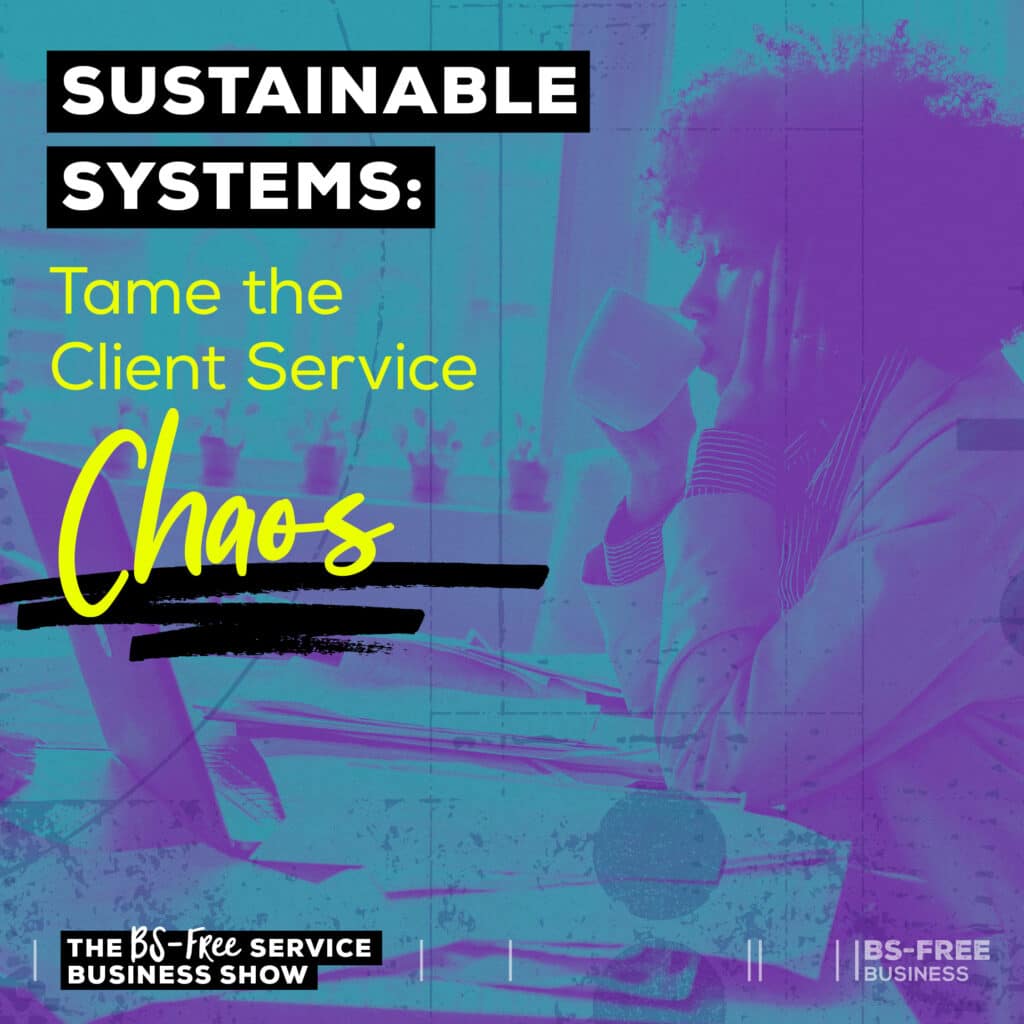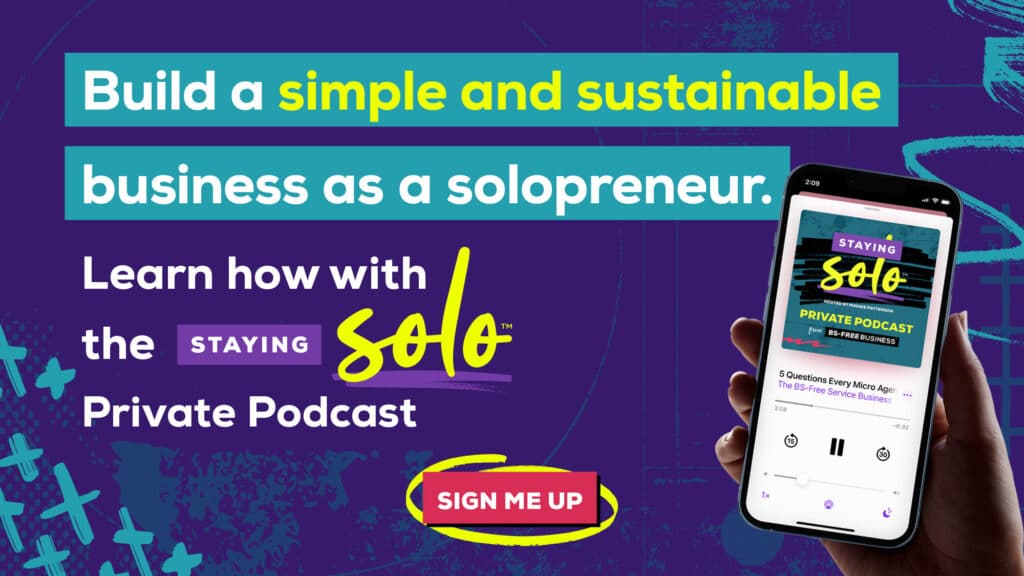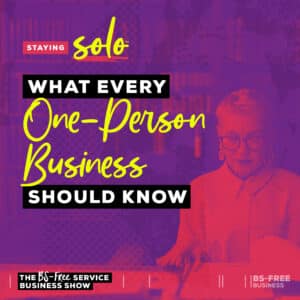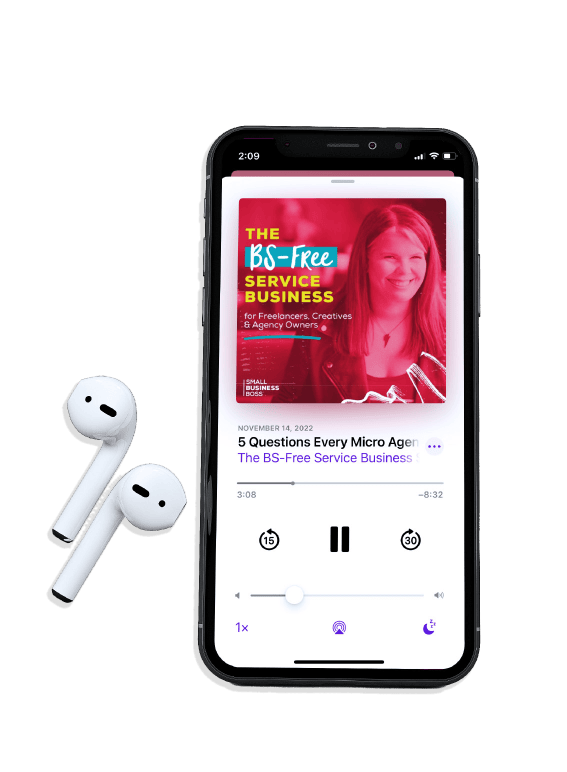
Search the site:
Sustainable Systems: Tame the Client Service Chaos
We’ve all been there. We’re overwhelmed and ready to burn it all down if one more client asks you one more question. It’s chaos, and you’re out of capacity for any of it.
In this episode, we examine how sustainable client service systems can help you tame the chaos.
When you started your service business, if you’re like most people, it’s because you had a specific set of skills and experiences. You may do creative or consulting work or have worked in an agency or a non-profit, but it doesn’t automatically mean you have the countless skills required to serve clients.
We don’t think of these as skills, but they really are. In my case, I’ve been building them for over 20 years, so I’ve got the benefit of a lot of trial and error.
From payments to communications to project management and everything in between, there are many moving parts with client services. All of which require skills, systems, and, ultimately, our brain power.
And all of those parts? Whether we started a business knowing how to do them or not, they’re critical to our business and our success. How we manage them can make or break our business.
Think about the last time you had a bad customer service experience. It feels bad when you’re on the receiving end, and it can lead to losing trust or even not doing business with that company again.
What I’m not talking about is a client who has turned into the client from hell, but rather one where you didn’t have the skills or systems in place, and chaos reigned supreme. Where things got away from you and things went sour.
This may be the quality of work slipping, a lack of professionalism, or poor communication. All of these, especially if they add up over time, can lead to the end of a client relationship.
A customer experience study from consulting firm PWC found that in the U.S. 17% of customers will walk away after one bad experience and 59% after several bad experiences.
As micro businesses, we can prevent these types of experiences from ever happening. Investing in our client experience is good for business as conventional wisdom is that it costs between five and 25 times more to find a new customer than to keep an existing one.
By being proactive with our customer service, we can retain our clients, expand our relationships, and have them happily refer us.
As someone who tends to have long-standing retainer client relationships , focusing on client service has always been my number one priority and my best growth strategy.
I can point to multiple client examples whereby building that relationship and providing great service; we could 2x or 3x the size of the original monthly retainer.
It’s Not a Time Management Issue; It’s a Capacity Issue
By now, you’re probably thinking of a cringe client situation where you dropped the ball. I get it. It’s happened to me, and frankly, it’s embarrassing. It feels like crap, even when I think about it years later.
So before we talk about specific systems to have in place to deal with your client service, I want to acknowledge that you’re human. You have limited resources as a business owner, and your capacity is limited.
We often think of client service challenges as being the result of needing more time. I actually think the bigger issue is the limited capacity we have for keeping track of everything, making decisions, and communicating on a day-to-day basis. (This is a big reason I encourage my clients to limit how many clients they have at any given time.)
When you have a full (or overfull) client roster, a brain that can only hold so much info, a life to live, and you don’t want to work around the clock, something has got to give.
That’s why systems are so crucial. The right client service systems help you make the most of your capacity by removing the ongoing emotional, energetic, and cognitive load of these activities.
Yes, you have to do them, but you’re no longer spending your time obsessing over how you’re doing to do them, trying to reinvent the wheel, or procrastinating on doing them because you’re not sure where to start. Having client service systems helps you proactively prevent problems before they even start. And it forces you to be much more realistic about what you can commit to and get done in a given day, week, or month.
What Client Service Systems Do You Need?
Next up, let’s talk about what systems you need for client service. Some of these you may have in place already, some of them may need help, and others you may not even look at them as a system.
When you think about systems, I want you to forget the 73-page SOP or fancy complicated BS and return to basics. As discussed in the last episode, your system is a way of pre-determining when/how you’ll do something, the tools you need, and the templates required.
That’s it. Simple is sustainable when it comes to your systems.
My favorite client service systems are the ones that anticipate potential issues and eliminate them from day one.
One of the hardest parts of running a service business is that we’re imperfect humans working with other imperfect humans. You simply can’t assume your clients know how to work with you or even know what you’re expecting. My policy is to leave nothing to chance and communicate constantly.
With that, let’s look at a few common challenges that can be addressed with systems:
Payment Problems
You likely don’t think of payments as a system, but it’s the top system you need in your business. You need to have a clear plan for how/when/where you take payments, what the expectations are, and communicate that from day one with potential clients. Payment policies and procedures take the messiness out of potentially awkward client situations, as it’s factual. We take payment via ACH, and we invoice on the 25th of the month, full stop.
Client Has a Case of the What Abouts
This is one of my least favorite client situations. This is where the client is nagging you about a deadline, the status of an item, or something else. This usually comes down to the client not having a clear line of sight into where things are (which can be fixed with a project management system) and a communications system so they’re clear on the status, timeline, or deadline.
By being proactive about it, you can cut this off at the pass as they’re not left wondering. This is a great place to implement a regular communication cadence so they know what’s up and what’s needed. Even if you think they should know, it’s always better to overcommunicate with clients.
Mismatched Expectations
Maybe you’ve got a client who wants to “jump on Zoom” all the time, or they expect a response to their message in your project management system within the hour. I’m the first to admit that expectations can be tricky, so this is a matter of having a clear set of boundaries (aka the rules of client engagement) that are communicated in your onboarding and then reinforced consistently.
These are just a few examples of some of the most common places where clients can push our buttons, but with some planning, we can have a system in place to be as proactive as humanly possible. Plus, having a system helps protect us from making exceptions and enables you to reinforce how you work with clients when needed.
What Client Service Systems Do You Need?
If you’re thinking about what systems you need in your service business, here are just a few of the must-haves:
- Payments/Invoicing
- Onboarding
- Calendar/Call Management
- Project Management
- Ongoing Communications
- Offboarding
For each of these, you can make the key decisions so there’s a clear plan for what, when, and how to do it. This can be as simple as a one-page Google doc with the key question answered, details on the tools used, and links to any templates you may use.
For your tools, I want to encourage you to keep them simple. There are so many amazing platforms, but they can be a huge waste of time and money if they don’t work for you or your clients.
For example, a lot of my clients use Dubsado, and it works great for them. We don’t need an all-in-one system and seamlessly use Proposify and Harvest instead. Stick with what works until it doesn’t work for you anymore.
Finally, when it comes to templates, this can be everything from canned emails to a format for status reports or a library of scripts for situations that pop up periodically, like what’s included in the Client Communications Kit.
Speaking of which, if you’re listening to this episode in real-time, everything in the BS-Free Shop is currently 35% off until May 24th.
We have multiple products in there that can help you with your client service systems, but I definitely recommend you check out the new Brave Boundaries Workshop and our latest bundle, the Client Comms Bundle which includes Brave Boundaries, the Client Communications Kit and Outstanding Onboarding for one price. The bundle is 10% off when purchased as a group, and this week you can take an extra 35% off.


I’m Maggie Patterson (she/her), and services businesses are my business.
I have 20+ years of experience with client services, am a consultant for agency owners, creatives, and consultants, and vocal advocate for humane business practices rooted in empathy, respect, and trust.
Help Not Hype

Tired of the same old BS business advice?
I got you with weekly emails packed full of proven strategy that makes a real difference in your service business.









